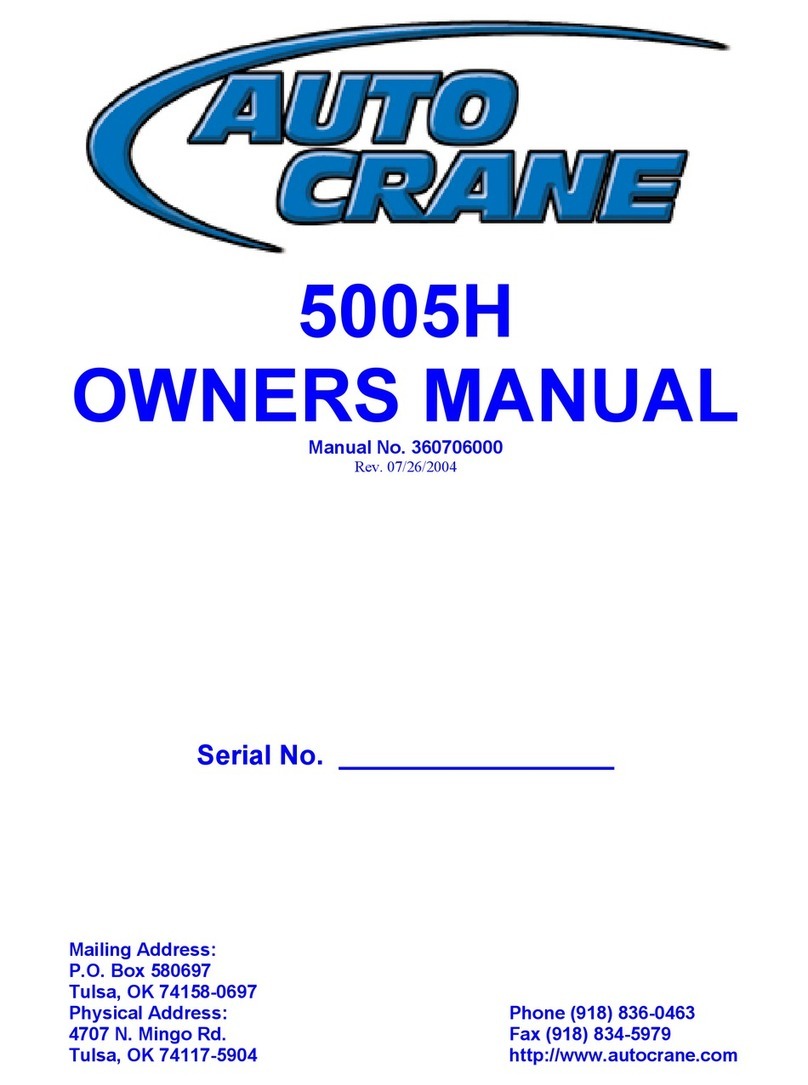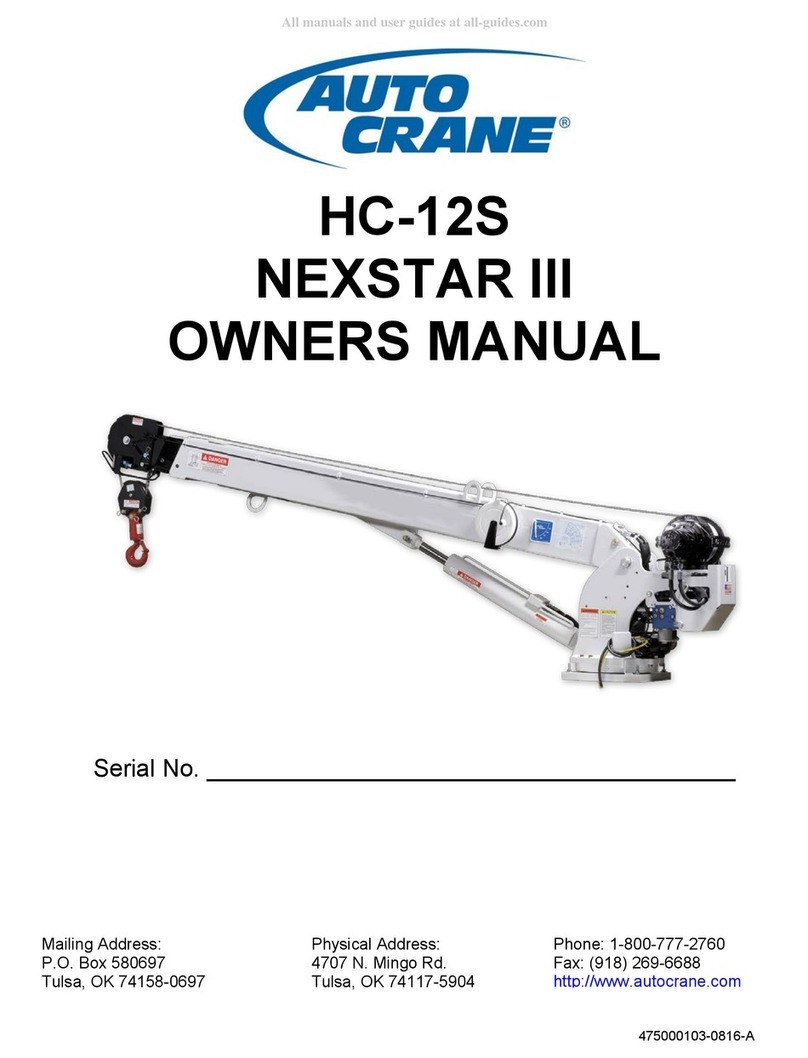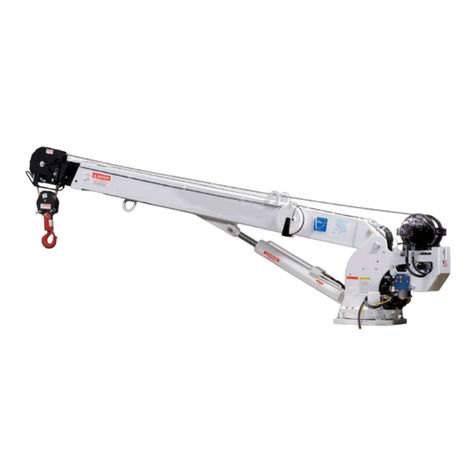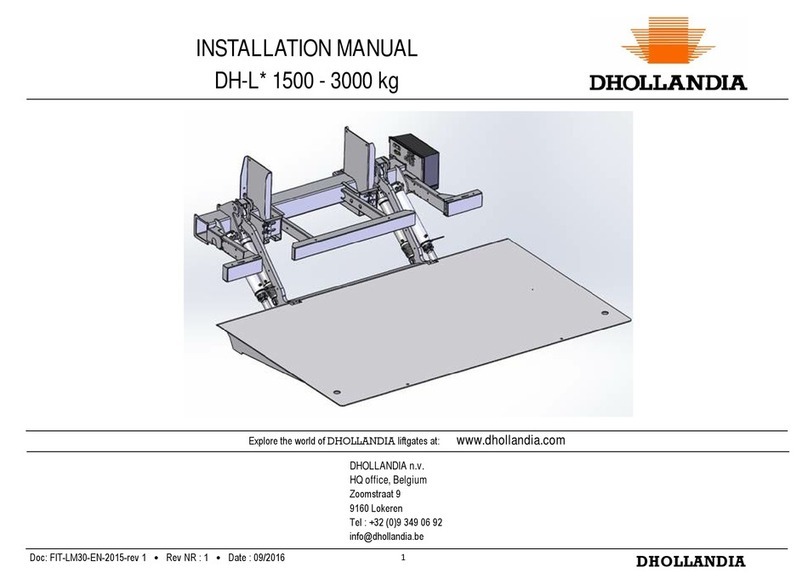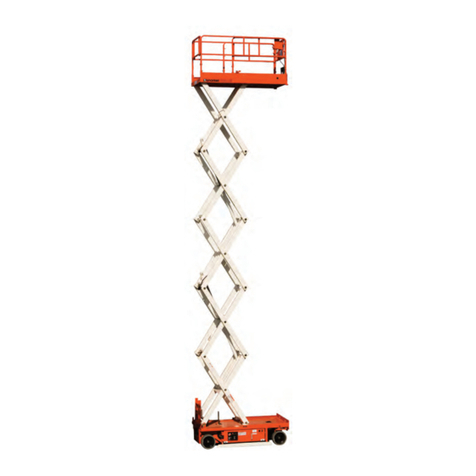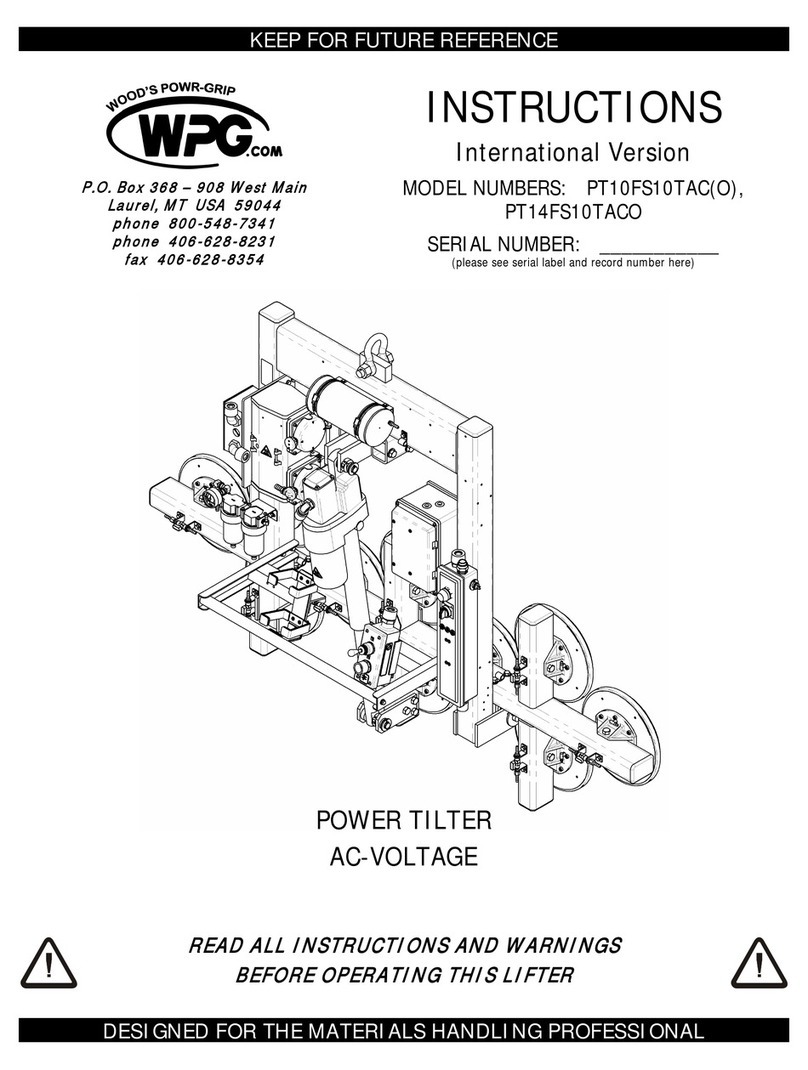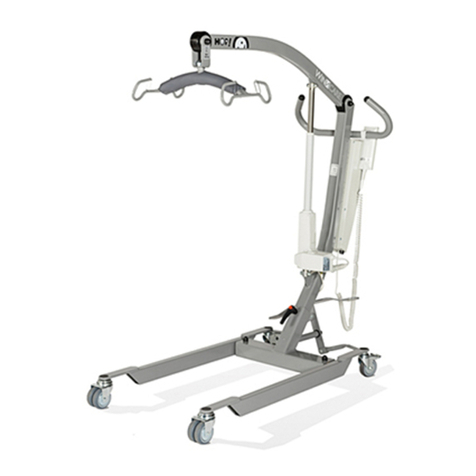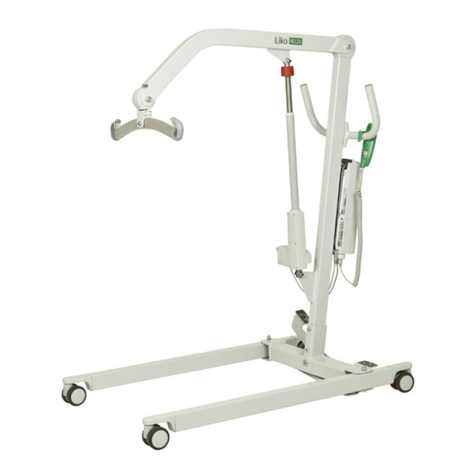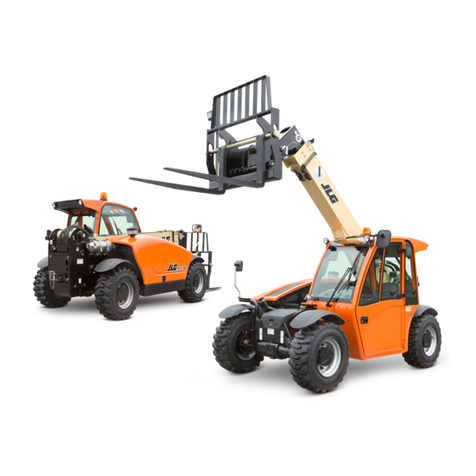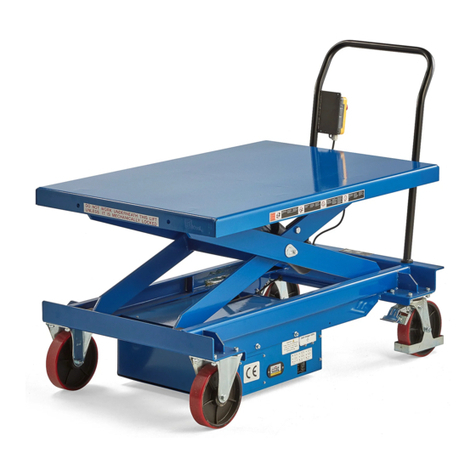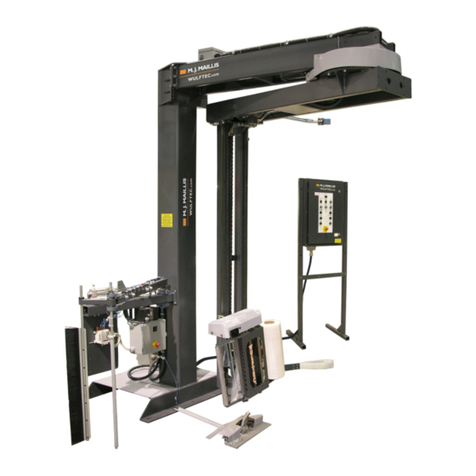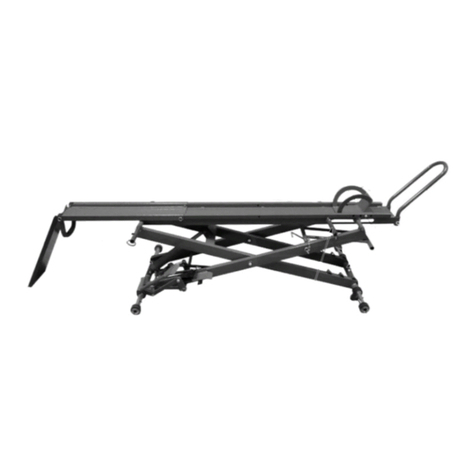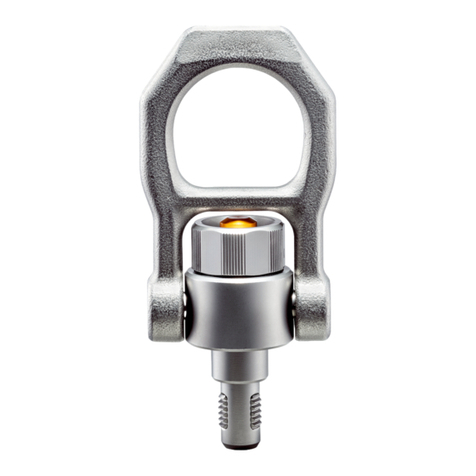Auto Crane 6006EH User manual

6006EH
OWNERS MANUAL
Manual No. 366904000
Rev. 09/12/05
Serial No. __________________
Mailing Address:
P.O. Box 580697
Tulsa, OK 74158-0697
Physical Address: Phone (918) 836-0463
4707 N. Mingo Rd. Fax (918) 834-5979
Tulsa, OK 74117-5904 http://www.autocrane.com


To: Fax:
From: Date:
Re: Pages:
Name: Phone:
Address:
City: State: Zip:
Contact:
Name:
Address:
City: State: Zip:
Contact:
VIN #
ONE REGISTRATION FORM PER UNIT (CRANE OR BODY)
Registration form must be mailed or faxed within 15 days of customer installation.
Mail to:
Warranty Department
Auto Crane Company
P.O. Box 581510
Tulsa, OK 74158-0697
Date Product Delivered: Date Processed:*
* For Auto Crane use only
Product Information: (Required for Warranty Activation)
Model No.: Serial No.:
E-mail Address:
Distributor Information: (Required for Warranty Activation)
Product Registration
E-mail Address:
(Required for Warranty Activation)
Auto Crane Warranty Registration
(918) 834-5979Warranty Department
End User Information:
Fax Transmission
Warranty Registration Rev. 072403


6006EH
OWNER’S MANUAL REVISION RECORD
Revision
Date
Section(s)
Or
Page(s) Description of Change
07/30/04 All New Design
02/03/05 2-4.1, 5-1.1, 6-2,1
& Sect 8 Added FM Crane
09/12/05 All General revision: added FM/Hardwire Less Slip Ring
Notes:
1. The information contained in this manual is in effect at the time of this printing. It does
not cover all instructions, configurations, accessories, etc. If you require additional
information, please contact Auto Crane Company at (918) 836-0463.
2. Auto Crane Company reserves the right to update this material without notice or
obligation.


WARNINGS
READ THIS PAGE
8/15/05
WARNING! Federal law (49 cfr part 571) requires that the Final Stage Manufacturer of a vehicle
certify that the vehicle complies with all applicable federal regulations. Any modifications performed
on the vehicle prior to the final state are also considered intermediate stage manufacturing and must
be certified as to compliance. The installer of this crane and body is considered one of the
manufacturers of the vehicle. As such a manufacturer, the installer is responsible for compliance
with all applicable federal and state regulations, and is required to certify that the vehicle is in
compliance.
WARNING! It is the further responsibility of the installer to comply with the OSHA Truck Crane
Stability Requirements as specified by 29 CFR part 1910.180 (C) (1).
WARNING! NEVER OPERATE THE CRANE NEAR ELECTRICAL POWER LINES!
Death or serious injury will result from boom, line, or load contacting electric lines. Do not use crane
within 10 feet (3.05m) of electric power lines carrying up to 50,000 volts. One-foot additional
clearance is required for every additional 30,000 volts or less. SEE DANGER DECAL (P/N 040529)
in this Owner's Manual.
WARNING! NEVER.........................................
♦EXCEED load chart capacities (centerline of rotation to hoist hook).
♦Un-reel last 5 wraps of cable from drum!
♦Wrap cable around load!
♦Attempt to lift or drag a load from the side! The boom can fail far below its rated capacity.
♦Weld, modify, or use unauthorized components on any Auto Crane unit! This will void any
warranty or liability. Also failure of the crane may result.
♦Place a chain link on the tip of the hook and try to lift a load!
♦Use a sling bar or anything larger than the hook throat that could prevent the hook latch from
closing, thus negating the safety feature!
♦Hold on any pendant Select Switch that will cause unsafe operating conditions!
WARNING! In using a hook with latch, ALWAYS make sure that the hook throat is closed before
lifting a load! Proper attention and common sense applied to the use of the hoist hook and various
slings will prevent possible damage to material being hoisted and may prevent injury to personnel.
WARNING! Failure to correctly plumb and wire crane can cause inadvertent operation and damage
to crane and/or personnel!
WARNING! Auto Crane Company remote controlled cranes are not designed or intended for use for
any applications involving the lifting or moving of personnel.
WARNING! ALWAYS operate the crane in compliance with the load capacity chart. DO NOT USE
the overload shutdown device to determine maximum rated loads, if the crane is equipped with this
type of device.


6006EH
TABLE OF CONTENTS
09/12/05
INTRODUCTION 1-1.0
GENERAL SPECIFICATIONS 1-2.0
SAFETY TIPS AND PRECAUTIONS 2-1.0
OPERATING PRACTICES & WARNINGS 2-3.0
QUALIFICATIONS FOR OPERATORS 2-4.0
OPERATION OF UNIT / OUTRIGGERS 2-7.0
CONTROLLER OPERATIONS 2-8.0
INSPECTION 3-1.0
TESTING 3-4.0
MAINTENANCE 3-5.0
BATTERIES 3-7.0
LUBRICATION AND MAINTENANCE SCHEDULE 3-9.0
SAFETY DECAL SECTION 4-1.0
GENERAL DIMENSIONS 5-1.0
MOUNTING AND INSTALLATION 5-2.0
GENERAL ASSEMBLY, HARDWIRED (W/SLIP RING & W/O SLIP RING) 6-1.0
PEDESTAL ASSEMBLY, HARDWIRED 6-5.0
BOOM ASSEMBLY 6-13.0
ROTATION GEARBOX 6-15.0
HOIST ASSEMBLY 6-17.0
TRAVELING BLOCK ASSEMBLY 6-20.0
ELECTRICAL SECTION, HARDWIRED 7-1.0
PENDANT CONTROL ASSEMBLY 7-5.0
HYDRAULIC SECTION 8-1.0
GENERAL ASSEMBLY, FM, (W/SLIP RING & W/O SLIP RING) 9-1.0
PEDESTAL ASSEMBLY, FM 9-5.0
ELECTRICAL SECTION, FM 10-1.0
DIAGNOSTICS 12-1.0
LOAD CHART 13-1.0
WARRANTY LAST PAGE


6006EH
INTRODUCTION
1-1.0 9/12/05
Auto Crane products are designed to
provide many years of safe, trouble-free,
dependable service when properly used and
maintained.
To assist you in obtaining the best service
from your crane and to avoid untimely crane
and/or vehicle failure, this manual provides
the following operating and service
instructions. It is specifically recommended
that all operating and service personnel
consider this manual as mandatory material
for reading and study before operating or
servicing Auto Crane products. It is highly
recommended that crane owners, equipment
managers, and supervisors also read this
manual.
Auto Crane has incorporated several safety
features in the 6006EH crane for your
protection.
For your convenience the overall
dimensions of the 6006EH crane are
included on the General Dimension
Drawing. Rotation and turning radius are
also listed on that drawing.
Remember, the crane adds weight to the
vehicle. Adding weight may change the
driving and riding characteristics of the
vehicle unless the appropriate overload
spring(s) are installed on the truck. The
payload of the vehicle is reduced by the
weight of the crane. The operator should
exercise care when loading the vehicle.
Distributing the payload on the vehicle
evenly will greatly improve the driving and
riding characteristics of the vehicle.
Auto Crane Company issues a limited
warranty certificate with each unit sold.
See last page for warranty.
The 6006EH cranes are attached to your
truck electrical system through the Voltage
Switching Unit provided. The 6006EH is
another highly efficient Auto Crane product.
The use of a maintenance-free battery is not
recommended on any Auto Crane product.
The recommended alternator and battery
that will give the longest life with the most
useful duty cycle is a 75-amp
alternator with a 500 cold cranking amp
battery. These specifications should be
considered minimum.
It has always been Auto Crane Company
policy to handle all warranty claims we receive
as promptly as possible. If a warranty claim
involves discrepant material or workmanship,
Auto Crane will take immediate corrective
action. It is understandable that Auto Crane
Company cannot assume responsibility of
liability when it is obvious that our products
have been abused, misused, overloaded or
otherwise damaged by inexperienced persons
trying to operate the equipment without
reading the manual.
Auto Crane will not assume responsibility
or liability for any modifications or
changes made to unit, or installation of
component parts without authorization.
Auto Crane maintains a strong distributor
network and a knowledgeable Customer
Service Department. In most cases, an
equipment problem is solved via phone
conversation with our customer service
department. The customer service department
also has the ability to bring a local distributor,
a regional sales manager, or a factory
serviceman into the solution of an equipment
problem.
If, through no fault of Auto Crane Company, it
is necessary to send an experienced factory
serviceman on a field service call the rates
stated in the Auto Crane Distributor's Flat Rate
Manual will apply.
Auto Crane Company's extensive Research
and Development Program allow our
customers to use the best equipment on the
market. Our Engineering Staff and our
knowledgeable sales people are always
available to our customers in solving crane
and winch-type application problems. When in
doubt, call the Auto Crane factory.
Note: This manual should remain with the
crane at all times.

6006EH
INTRODUCTION
1-2.0 9/12/05
DISTRIBUTOR ASSISTANCE:
Should you require any assistance not given
in this manual, we recommend that you
consult your nearest Auto Crane Distributor.
Our distributors sell authorized parts and
have service departments that can solve
almost any needed repair. This manual
does not cover all maintenance, operating,
or repair instructions pertinent to all possible
situations. If you require additional
information, please contact the Auto
Crane Company at the following
telephone number: (918) 836-0463. The
information contained in the manual is in
effect at the time of this printing. Auto Crane
Company reserves the right to update this
material without notice or obligation.

6006EH
GENERAL SPECIFICATIONS
1-2.0 09/12/05
DIMENSIONS
Width: 21.75 in (0.55 m)
Height: 35.88 in (0.91 m)
Length: 13 ft 1 in (3.99 m)
[boom(s) stored]
Weight:
1,670 lbs (758 kg)
CAPACITY
36,000 ft-lbs (4.98 ton-m)
[ft-lbs = horizontal distance from centerline
of rotation to free hanging weight (feet) x
amount of weight (pounds)]
ft lbs ft lbs
3 6,000 12 3,000
4 6,000 13 2,769
5 6,000 14 2,571
6 6,000 15 2,400
7 5,143 16 2,250
8 4,500 17 2,118
9 4,000 18 2,000
10 3,600 19 1,895
11 3,273 20 1,800
LIFTING CAPACITIES
REACH
Second boom will reach from 10 feet 4
inches to 16 feet 4 inches.
Third boom will reach from 16 feet 4
inches to 20 feet 4 inches.
CABLE
95 ft (28.9 m) of 3/8 in (9.5 mm)
diameter aircraft quality cable. This cable
has a single line breaking strength of
14,400 lbs (6,531 kg).
CHASSIS REQUIREMENTS
14,500 lbs (6,577 kg) GVWR minimum
360,000 in-lbs RBM
ELECTRICAL SYSTEM
REQUIREMENTS
Voltage: 12 VDC
Alternator: 75 amp (minimum)
Battery: 130 minute reserve
capacity (minimum)
Maintenance type
ROTATION
370º Rotation With Electrical Stop
Continuous Rotation With Slip Ring

--- IMPORTANT ---
SAFETY TIPS AND PRECAUTIONS
2-1.0 8/16/05
1. No unqualified or unauthorized person shall be
allowed to operate the crane.
2. WARNING: Never weld, modify, or use
unauthorized components / parts on any Auto
Crane unit. This will void any warranty or
liability. Also, failure of the crane may result.
3. Make certain the vehicle meets minimum
chassis requirements. (These requirements do
not guarantee unit stability.)
4. Make certain the crane is installed per factory
specifications. Contact your local distributor or
the Auto Crane factory if any questions arise.
5. Visual inspections and tests should be
conducted at the beginning of each shift each
day to insure that the crane and all its operating
systems are in good condition and working order
before it is used.
6. Inspect hydraulic hoses frequently for signs of
deterioration, and replace them as required.
7. If a hydraulic break occurs, leave the area of the
break and do not attempt to stop the break by
hand as the hydraulic oil may be hot and under
high pressure which can cause serious injury.
Shut the system down as soon as possible.
8. Check the hook at least every thirty days for
distortions or cracks and replace it as required.
9. Oil gears as required.
10. Stop all operations when cleaning, adjusting or
lubricating the machine.
11. Keep dirt and grit out of moving parts by keeping
crane clean. Make sure machine is free of
excess oil, grease, mud and rubbish, thus
reducing accidents and fire hazards.
12. When a new cable is installed, operate first with
a light load to let the cable adjust itself.
13. Locate the vehicle at the work site for the best
stability possible.
14. Keep the vehicle in a level position while loading
or unloading.
15. Observe operating area for obstructions and/or
power lines that might be a hazard.
16. WARNING: NEVER OPERATE THE CRANE
NEAR ELECTRICAL POWER LINES. Auto
Crane Company recommends that the crane
never be any closer to a power line (including
telephone lines) than 10 feet at any point.
17. Allow the vehicle engine to warm up before
operating crane.
18. Know the weight of your rigging and load to
avoid overloading the crane.
19. Deduct the weight of the load handling
equipment from the load rating to determine how
much weight can be lifted.
20. All load ratings are based on crane capacity,
NOT the vehicle stability. Remember in lifting a
heavy load, the weight can create enough
tipping moment to overturn the vehicle
21. Always comply with load chart capacities,
(centerline of rotation to hook).
22. Secure all loads before lifting.
23. Always set the emergency brake before
beginning operation.
24. Keep objects and personnel clear of crane path
during operation.
25. Operate control levers slowly and smoothly in
order to meter oil flow for safe operation.
26. Always extend the outriggers from vehicle to the
ground before crane operation. Insure that they
are firmly positioned on solid footings. Stand
clear of outriggers while they are being
extended.
27. If any outrigger, when extended, rests on a curb
or other object that prevents it from extending to
its maximum distance, shorten bearing or
fulcrum point and reduce the maximum load
accordingly.
28. When an outrigger will not reach the ground due
to holes or grades, it shall be blocked up to
provide level and firm support for the truck.
29. When working in soft earth, use wide pads
under outrigger feet to prevent sinking.
30. Always store outriggers before transportation.
WARNING!
Auto Crane Company cranes are not designed or intended for use in lifting or moving persons. Any
such use shall be considered to be improper and the seller shall not be responsible for any claims
arising there from. This sale is made with the express understanding that there is no warranty that
the goods shall be fit for the purpose of lifting or moving persons or other improper use and there is
no implied warranty or responsibility for such purposes.

--- IMPORTANT ---
SAFETY TIPS AND PRECAUTIONS
2-2.0 8/16/05
31. Always store the crane in its stowed position
for transportation.
32. Remember the overall height of the entire
unit for garage door clearance or when
moving under objects with low overhead
clearance
33. Disengage power takeoff (PTO) before
moving the vehicle.
34. Always walk around the vehicle before
moving.
35. Never drive with a load suspended from
crane.
36. Do not take your eyes off a moving load.
Look in the direction you are moving.
37. Never swing a load over people.
38. Do not stop the load sharply in midair so that
it swings like a pendulum. Meter the control
levers to avoid this situation.
39. Crane boom length should be kept as short
as possible for maximum lifting capacity and
greater safety. Longer booms require
additional care in accelerating and
decelerating the swing motion, and thus slow
down the working cycle and reduce
productivity.
40. Keep the load directly and vertically under
the boom point at all times. Crane booms
are designed to handle vertical loads, not
side lifts.
WARNING: Never attempt to lift, drag, tow or
pull a load from the side. The boom can fail
far below its rated capacity.
41. Do not push down on anything with boom
extensions; similarly do not lift anything with
boom extensions.
42. Do not lift personnel with any wire rope
attachment or hook. There is no implied
warranty or responsibility for such purposes.
43. WARNING: In using a safety hook, ALWAYS
close the hook throat before lifting a load.
Proper attention and common sense applied
to the use of the hook and various slings will
prevent possible damage to material being
hoisted and may prevent injury to personnel.
44. WARNING: Never place a chain link on the
tip of the hook and try to lift a load with the
hoist.
45. WARNING: Never use a sling bar or
anything larger than the hook throat which
could prevent the safety latch from closing,
thus negating the safety feature.
46. Do not wrap the wire rope around sharp
objects when using winch.
47. WARNING: Never unreel last 5 wraps of
cable from drum.

--- IMPORTANT ---
OPERATING PRACTICES AND WARNINGS
2-3.0 7/27/05
1. Make certain the vehicle meets minimum chassis
requirements. (These requirements do not
guarantee unit stability)
2. Make certain the crane is installed per factory
specifications. Contact your local Distributor or the
Auto Crane factory if any questions arise.
3. Keep the vehicle in as level a position as possible
while loading or unloading.
4. ALWAYS set the vehicle emergency brake before
beginning crane operations.
5. ALWAYS use outriggers from vehicle to the ground
during crane operation. Make sure they are firmly
positioned on solid footings.
6. All load ratings are based on crane capacity, NOT
truck/crane stability.
7. Keep objects and personnel clear of crane path
during operation.
8. Keep hoist cable pulled tight at all times.
9. REMEMBER, in lifting a heavy load, the weight can
create enough tipping momentum to overturn the
vehicle.
10.ALWAYS keep load as close to ground as
possible.
11.Hydraulic hoses need to be inspected frequently for
signs of deterioration, and be replaced as required.
12.The hoist hook is an important item that an operator
should consider and use properly. It should be
checked on a daily basis for distortion or cracks.
13.ALWAYS store outriggers before road travel.
14.WARNING! NEVER OPERATE THE CRANE
NEAR ELECTRICAL POWER LINES! Death or
serious injury will result from boom, line, or load
contacting electric lines. Do not use crane within
10 feet (3.05m) of electric power lines carrying up
to 50,000 volts. One foot additional clearance is
required for every additional 30,000 volts or less.
15.WARNING! NEVER EXCEED load chart
capacities (centerline of rotation to hoist hook).
16.WARNING! NEVER un-reel last 5 wraps of
cable from drum!
17.WARNING! NEVER wrap cable around load!
18.WARNING! NEVER attempt to lift or drag a load
from the side! The boom can fail far below its
rated capacity.
19.WARNING! NEVER weld, modify, or use
unauthorized components on any Auto Crane
unit! This will void any warranty or liability. Also
failure of the crane may result.
20.WARNING! NEVER place a chain link on the tip
of the hook and try to lift a load!
21.WARNING! NEVER use a sling bar or anything
larger than the hook throat that could prevent the
hook latch from closing, thus negating the safety
feature!
22.WARNING! In using a hook with latch, ALWAYS
insure that the hook throat is closed before lifting
a load! Proper attention and common sense
applied to the use of the hoist hook and various
slings will prevent possible damage to material
being hoisted and may prevent injury to
personnel.
WARNING! NEVER hold any Control Select
Switch on that will cause unsafe operating
conditions!
WARNING!
Auto Crane Company remote controlled, stiff boom cranes
are not designed or intended for use on any applications
involving the lifting or moving of personnel.

QUALIFICATIONS FOR AND CONDUCT OF
OPERATORS AND OPERATING PRACTICES
2-4.0 8/19/05
REFERENCE ASME B30.5a AND OSHA 1910.180 FOR COMPLETE QUALIFICATION
REQUIREMENTS
OPERATORS
1. Crane operation shall be limited to personnel
with the following minimum qualifications:
A. Designated persons.
B. Trainees under the direct supervision of a
designated person.
C. Maintenance and test personnel (when it is
necessary in the performance of their
duties).
D. Inspectors (crane).
2. No one other than the personnel specified
above shall enter the operating area of a crane
with the exception of persons such as oilers,
supervisors, and those specified persons
authorized by supervisors whose duties require
them to do so and then only in the performance
of their duties and with the knowledge of the
operator or other persons.
QUALIFICATIONS FOR OPERATORS
1. Operators shall be required by the employer to
pass a practical operating examination.
Qualifications shall be limited to the specific type
of equipment for which examined.
2. Operators and operator trainees shall meet the
following physical qualifications:
A. Vision of at least 20/30 Snellen in one eye
and 20/50 in the other, with or without
corrective lenses.
B. Ability to distinguish colors, regardless of
position, if color differentiation is required
for operation.
C. Adequate hearing with or without hearing
aid for the specific operation.
3. Evidence of physical defects or emotional
instability, which render a hazard to operator or
others, which in the opinion of the examiner
could interfere with the operator’s performance,
may be sufficient cause for disqualification. In
such cases, specialized clinical or medical
judgment and tests may be required.
4. Evidence that operator is subject to seizures or
loss of physical control shall be sufficient
reason for disqualification. Specialized medical
tests may be required to determine these
conditions.
5. Operators and operator trainees should have
normal depth perception, coordination, and no
tendencies to dizziness or similar undesirable
characteristics.
6. In addition to the above listed requirements, the
operator shall:
A. Demonstrate the ability to comprehend and
interpret all labels, operator’s manuals,
safety codes, and other information pertinent
to correct crane operations.
B. Posses the knowledge of emergency
procedures and implement it.
C. Demonstrate to the employer the ability to
operate the specific type of equipment.
D. Be familiar with the applicable safety
regulations.
E. Understand the operating procedures as
outlined by the manufacturer.
F. Be thoroughly familiar with the crane and its
control functions.
G. Understand the operating procedures as
outlined by the manufacturer.
CONDUCT OF OPERATORS
1. The operator shall not engage in any practice,
which will divert his attention while actually
operating the crane.
2. Each operator shall be responsible for those
operations under the operator's direct control.
Whenever there is any doubt as to safety, the
operator shall consult with the supervisor before
handling the loads.
3. The operator should not leave a suspended load
unattended unless specific precautions have been
instituted and are in place.
4. If there is a warning sign on the switch or engine
starting controls, the operator shall not close the
switch or start the engine until the warning sign has
been removed by the appointed person.
5. Before closing the switch or starting the engine, the
operator shall see that all controls are in the "OFF"

QUALIFICATIONS FOR AND CONDUCT OF
OPERATORS AND OPERATING PRACTICES
2-5.0 8/19/05
or neutral position and all personnel are in the
clear.
6. If power fails during operation, the operator shall:
A. Move power controls to the "OFF" or neutral
position.
B. Land the suspended load and boom, if
practical.
7. The operator shall be familiar with the
equipment and its proper care. If adjustments or
repairs are necessary, the operator shall report
the same promptly to the appointed person, and
shall also notify the next operator.
8. The operator at the start of each shift shall test
all controls. If any controls do not operate
properly, they shall be adjusted or repaired
before operations are begun.
9. Stabilizers shall be visible to the operator while
extending or setting unless a signal person
assists operator.
OPERATING PRACTICES/HANDLING THE
LOAD
1. Size of load.
A. No crane shall be loaded beyond the rated
load except for test purposes.
B. The load to be lifted is to be within the rated
load of the crane and its existing
configuration.
C. When loads that are not accurately known
are to be lifted, the person responsible for
the job shall ascertain that the weight of the
load does not exceed the crane rated load at
the radius at which the load is to be lifted.
2. Attaching the load.
A. The load shall be attached to the hook by
means of slings or other devices of sufficient
capacity.
B. Hoist rope shall not be wrapped around the
load.
3. Moving the load.
The operator shall determine that:
A. The crane is level and, where necessary,
the vehicle/carrier is blocked properly.
B. The load is well secured and balanced in
the sling or lifting device before it is lifted
more than a few inches.
C. Means are provided to hold the vehicle
stationary while operating the crane.
D. Before starting to lift, the hook shall be
positioned over the load in such a manner
as to minimize swinging.
E. During lifting care shall be taken that:
1. There is no sudden acceleration or
deceleration of the moving load.
2. Load, boom or other parts of the crane
do not contact any obstruction.
F. Cranes shall not be used for dragging loads
sideways.
G. This standard recognizes that telescopic
boom cranes are designed and intended for
handling materials. They do not meet
personnel lift or elevator requirements.
Therefore, no lifting, lowering, swinging or
traveling shall be done while a person is on
the hook or load. Hook attached suspended
work platforms (baskets) shall not be used
with cranes covered by this standard.
Crane manufacturer must approve work
platforms attached to the boom.
H. The operator should avoid carrying loads
over people.
I. When the crane is so equipped, the
stabilizers shall be fully extended and set.
Blocking under stabilizers shall meet the
requirements as follows:
1. Strong enough to prevent crushing.
2. Of such thickness, width and length as
to completely support the stabilizer pad.
J. Firm footing under all tires, or individual
stabilizer pads should be level. Where such
a footing is not otherwise supplied, timbers,
cribbing, or other structural members to
distribute the load so as to not exceed
allowable bearing capacity or the
underlying material should provide it.
K. In transit, the boom shall be carried in
stowed position.
L. When rotating the crane, sudden starts
and stops shall be avoided. Rotational
speed shall be such that the load does not
swing out beyond the radius at which it
can be controlled.
M. The crane shall not be transported with a
load on the hook unless recommended by
the manufacturer.

QUALIFICATIONS FOR AND CONDUCT OF
OPERATORS AND OPERATING PRACTICES
2-6.0 8/19/05
N. No person should be permitted to stand or
pass under a suspended load.
4. Stowing procedure.
Follow the manufacturer's procedure and
sequence when stowing and un-stowing the
crane.
MISCELLANEOUS
OPERATING NEAR ELECTRICAL POWER
LINES
1. Cranes shall be operated so that no part of the
crane or load enters into the danger zone shown
above.
EXCEPTIONS
A. The danger zone may be entered after
confirmation by an appointed person that the
electrical distribution and transmission lines
have been de-energized and visibly
grounded at the point of work; or
B. The danger zone may be entered if
insulating barriers (not a part of nor an
attachment to the crane) have been erected
to prevent physical contact with the lines.
2. For lines rated 50 kV or below, minimum
clearance between the lines and any part of the
crane or load (including handling appendages)
shall be 10-ft. (3m). For higher voltages, see
Table 1.
3. Caution shall be exercised when working near
overhead lines, because they can move
horizontally or vertically due to wind, moving the
danger zone to new positions.
4. In transit with no load and boom lowered the
clearance shall be specified in Table 1.
5. A qualified signalperson shall be assigned to
observe the clearance and give warning before
approaching the above limits.
A. Any overhead wire shall be considered to be an
energized line unless and until the person
owning such line or the electrical utility
authorities verify that it is not an energized line.
B. Exceptions to this procedure are allowed, if
approved by the administrative or regulatory
authority provided the alternate procedure
insures equivalent protection and is set forth in
writing.
C. Durable signs shall be installed at the operator's
station and on the outside of the crane, warning
that electrocution or serious bodily injury may
occur unless a minimum clearance of 10 ft.
(3.0m) between the crane or the load being
handled and energized power lines. Greater
clearances are required because of higher
voltage as stated above. These signs shall be
revised but not removed when local jurisdiction
requires greater clearances.
normal voltage, kV
(phase to phase) ft (m)
over to 50 10 (3.50)
over 50 to 200 15 (4.6)
over 200 to 350 20 (6.1)
over 350 to 500 25 (7.62)
over 500 to 750 35 (10.67)
over 750 to 1000 45 (13.72)
over to 0.75 4 (1.22)
over 0.75 to 50 6 (1.83)
over 50 to 345 10 (3.83)
over 345 to 750 16 (4.87)
over 750 to 1000 20 (6.1)
while in transit with no load and boom lowered
TABLE 1
minimum required
____clearance____
when operating near high voltage power lines

--- IMPORTANT ---
OPERATION OF UNIT
2-7.0 8/19/05
1. Make sure this manual has been thoroughly
read by all crane operating personnel and
supervisors.
2. A routine inspection of the crane should be
mandatory before each operating day. Any
defects should be corrected immediately.
3. At a job site the vehicle should be positioned so
that the crane can adequately reach the load
within the rated capacity (centerline of rotation
to hoist hook).
4. Keep the vehicle as level as possible during
operation.
5. For electric cranes, engage emergency brake
and leave ignition on with transmission in
neutral (or in park for automatic transmissions).
Activate any crane power switches. For Auto
Crane units requiring battery and hydraulic
operation, engage emergency brake, place
gear selector in neutral, press clutch, activate
PTO, release clutch and after hydraulic fluid is
warm, set throttle control to proper engine
speed.
6. Always use outriggers from the truck to the
ground. Be sure these are firm and adequately
positioned. When rotating, keep load as low to
the ground as possible.
7. Remove the transmitter from cab or storage
area. Power transmitter on. Detach hook from
dead man. Crane is now ready for operation.
8. Always boom up before rotating so the boom will
clear the required boom support.
9. When extending the boom, always maintain
clearance between the boom crown and the
traveling block or hoist hook.
10.Always observe safe and practical operation to
avoid possible accidents. Refer to Safety Tips
and Precautions.
11.After completing lifting operations, return the
boom to stowed position on the boom support.
Avoid unneeded pressure on the boom support.
12.Store transmitter in proper location (in cab or
storage area).
13.Return outriggers to stowed position. Make sure
they are pinned in place or jacklegs are returned
to compartment.
14.Check work area for any tools or equipment not
stored.
15.Release throttle control, depress clutch and
disengage PTO. Deactivate any crane power
switches.
16.Report any unusual occurrence during crane
operation that may indicate required maintenance
or repair.
17.NEVER use two cranes to support a load too
large for either crane.
OPERATION OF
OUTRIGGERS
HYDRAULIC OUTRIGGERS
1. Shift crane/outrigger control valve to
"outrigger" position.
2. Operate the outrigger control valves to
position the outriggers.
3. After outriggers are positioned, return
crane/outrigger selector to "crane"
position.
4. Crane is now ready to operate.
MANUAL OUTRIGGERS
1. Pull lock pins to release jackleg or drop
down outrigger and move to outermost
lock position.
2. Make sure lock pins are reinstalled
properly.
3. Lower outrigger pad to firm ground and
adjust foot to take out slack.
4. Crane is now ready to operate.
Other manuals for 6006EH
1
Table of contents
Other Auto Crane Lifting System manuals
